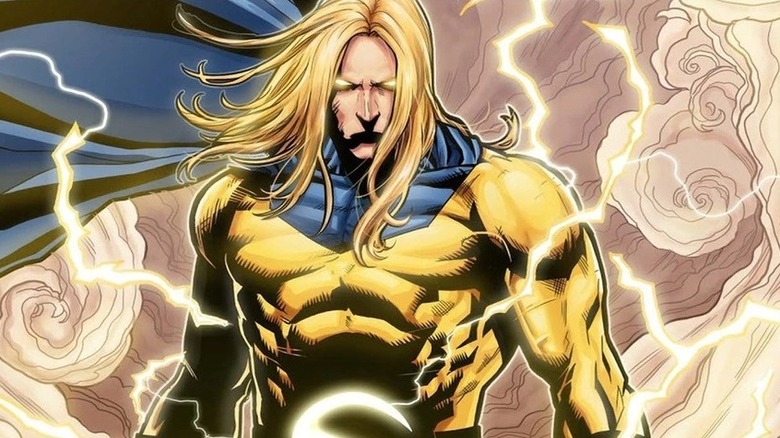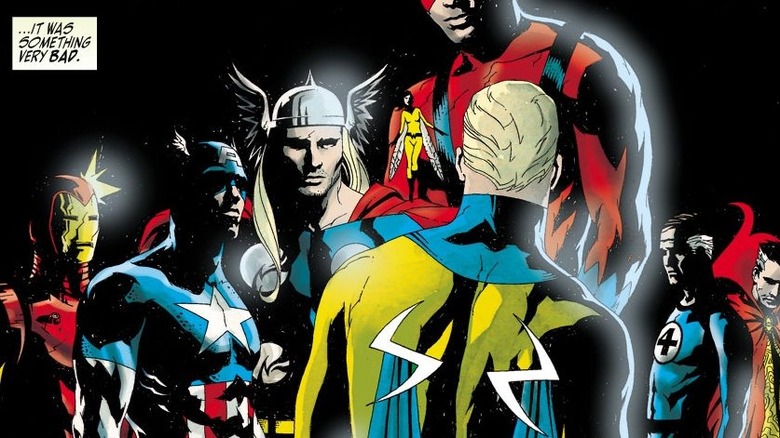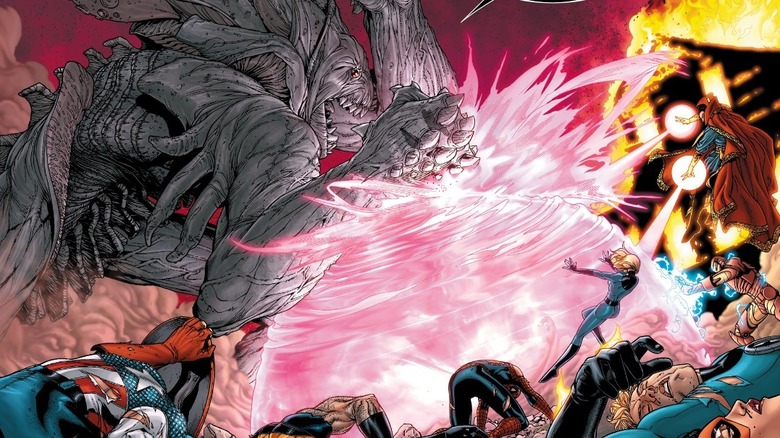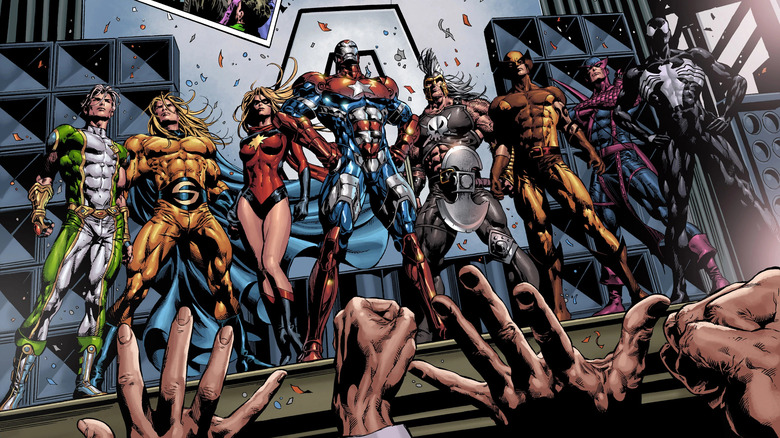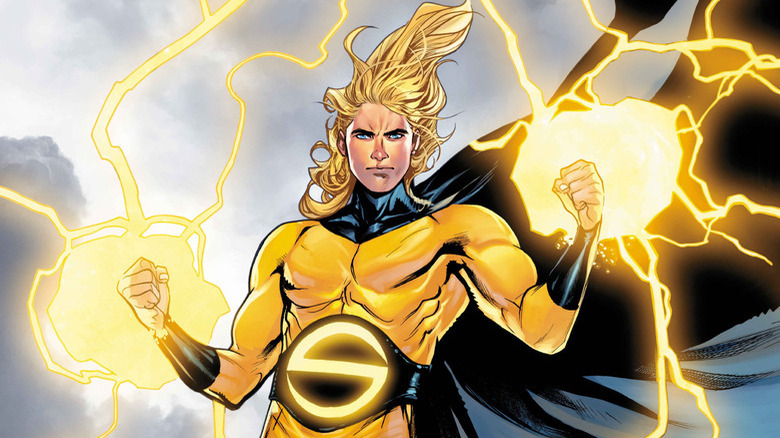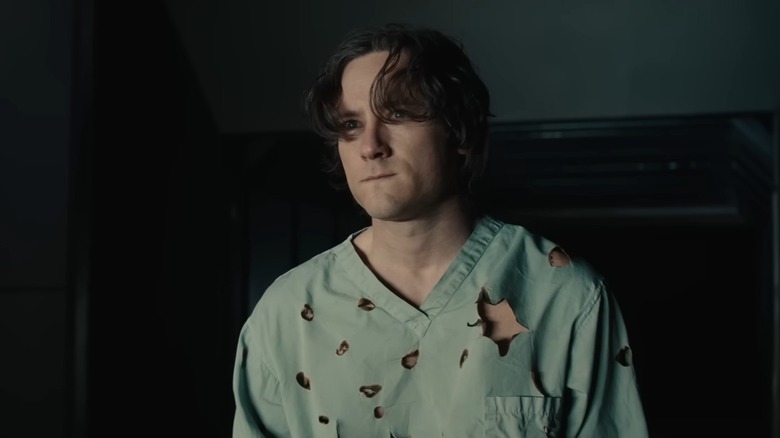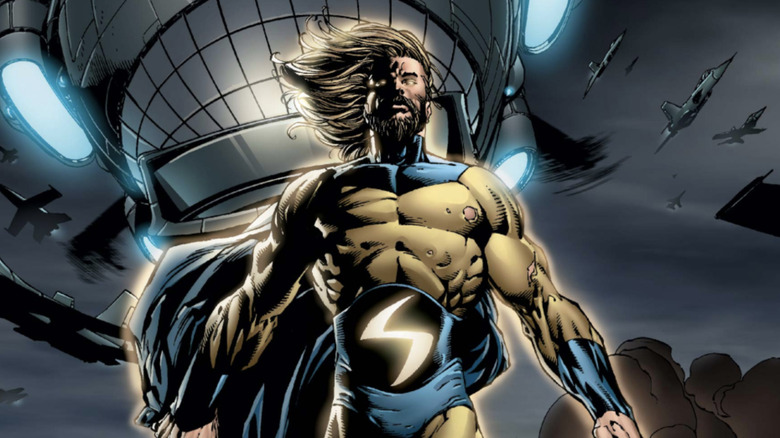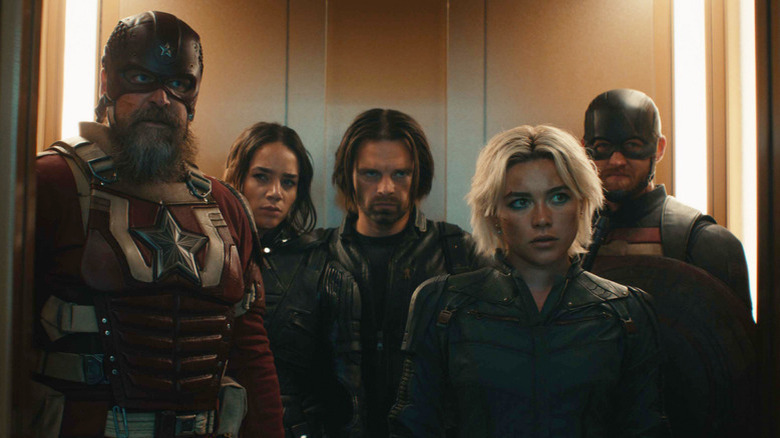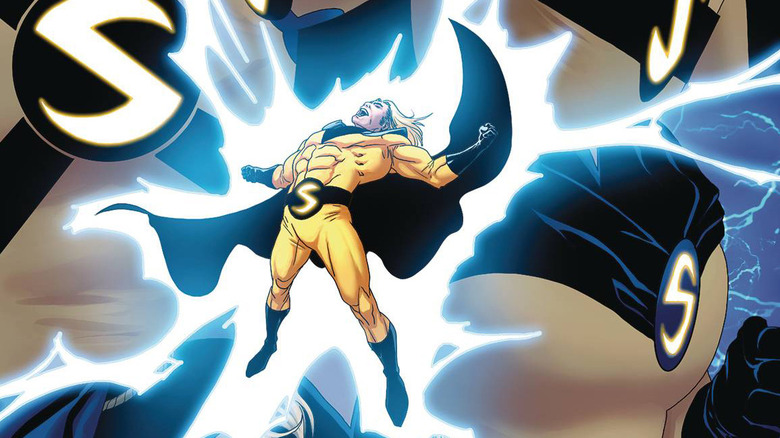Who Is Marvel's Sentry? The Thunderbolts* Villain Explained
We may receive a commission on purchases made from links.
Back in February 2023, Steven Yeun was announced to be joining the Marvel Cinematic Universe with a "key role" in "Thunderbolts*." He was later replaced by Lewis Pullman, though not before Robert Kirkman — the creator of "Invincible," in which Yeun plays the titular superhero — confirmed who Yeun was supposed to play (and, as such, who Pullman is now playing in the film): Robert Reynolds/The Sentry.
The Sentry is a relatively recent creation, debuting in 2000 and created by Paul Jenkins, Jae Lee, and Rick Veitch. He's one of the countless Superman clones across comics; he has the same powerset (flight, super strength, energy blasts, etc.), the flowing cape and S-insignia, he gets his powers from the sun (hence his golden costume and nickname, "The Golden Guardian of Good"), and he even boasts the classic alliterative secret identity (think "Clark Kent").
However, Mr. Reynolds is not all good. Afflicted with a personality disorder since he got his powers, his archenemy — the soul-devouring shadow "The Void" — is Reynolds' own alternate personality. Now that Bruce Banner (Mark Ruffalo) is the Hulk full-time and Wanda Maximoff (Elizabeth Olsen) was seemingly (?) crushed beneath Mount Wundagore, the Sentry easily slots in as the MCU's new Jekyll & Hyde anti-hero.
What should you know about the Sentry before he makes his film debut, and what can you expect from him? Let's get into it.
The comic book history of Thunderbolts* villain Sentry
The Sentry comes out of "Marvel Knights," an imprint started in the late 1990s for writers and artists to craft relatively more creator-driven and mature stories with Marvel's stable of characters. "The Sentry" was a miniseries by Jenkins and Lee about the greatest superhero no one had ever heard of.
Bob Reynolds is portrayed as a miserable middle-aged man with memories of being The Sentry, but no one else recalls them. The first issue leaves it ambiguous if he's delusional or not — until he starts flying in the last panel. Reynolds then visits other heroes of the Marvel Universe (the Fantastic Four, the Hulk, Spider-Man, and the X-Men) and speaks to them as old friends even though they're unable to remember him.
You see, Reynolds senses The Void is returning and they must marshal a defense. The twist, that Sentry and The Void are one and the same, comes in the final issue, "The Sentry Vs. The Void" #1. Discovering the truth of the Void, and that he and his superhero friends agreed to erase the Sentry to stop the villain, Bob accepts his "normal life" and everyone forgets about him again. The ending, though, suggests his memory of the Sentry is still in there somewhere.
"The Sentry" is a riff on Alan Moore's "Miracleman," also about a middle-aged mediocrity discovering long-lost memories of being a superhero. To sell the illusion of the Sentry having always been part of the Marvel universe, the series also includes flashbacks done in different art styles; the Sentry's origin story (he ingests a modified super soldier serum) and his teaming up with the Avengers to fight The Void in issue #1, for instance, are drawn in the style of Jack Kirby. This blocky, classical style contrasts with Lee's darkly shaded, sharper-edged art.
Sentry and The Void returned in New Avengers
"The Sentry" could've easily just been a one-off story, but it wasn't the end for Robert Reynolds after all.
The most important Marvel Comics writer of the 2000s was Brian Michael Bendis (he jumped ship to the Distinguished Competition in 2017, but that's another story). After knocking it out of the park on titles like "Ultimate Spider-Man," "Alias," and "Daredevil" thanks to his crime storytelling instincts and David Mamet-esque dialogue, he was charged with rebooting the Avengers in 2004.
Bendis' "New Avengers" opened with "Breakout" (drawn by David Finch); Electro breaks into the supervillain prison The Raft and frees all the inmates. The New Avengers form out of the first responders (Captain America, Iron Man, Spider-Man, Luke Cage, and Spider-Woman — Daredevil declines, and the sixth spot is filled by a late-to-the-party Wolverine).
"New Avengers" issue #1 ends by revealing Sentry is imprisoned in The Raft, having turned himself in for seemingly killing his wife Lindy. After some imploring, he uses his powers to save Daredevil and Foggy Nelson from Carnage (he flies the villain up into the atmosphere and rips him in half) but jets off after the riot is over.
The second "New Avengers" arc, titled "The Sentry," features the team tracking down Sentry and relearning his hidden existence — as far as they know, the Sentry is only a comic book character created by Paul Jenkins (talk about meta). It turns out Reynolds didn't kill his wife, but convinced himself he did to put another psychic block on his powers.
While the Avengers fight the shapeshifting Void, the X-Men's Emma Frost enters Reynolds' mind for telepathic therapy. It's revealed that the psychic mutant Mastermind erased the world's memories of the Sentry and planted the idea of The Void in Reynolds' head to restrain him; he wouldn't use his powers if he thought the cost was a terrible supervillain's existence.
Sentry joined forces with Norman Osborn in Dark Reign
The Sentry continued to be a supporting character in Brian Michael Bendis' Marvel saga, up to the storyline "Dark Reign." Some backstory: During Warren Ellis' "Thunderbolts," he made Norman Osborn/the Green Goblin the leader of the team (Ellis wrote Norman as a "Donald Rumsfeld-like public government official").
During Bendis' crossover event "Secret Invasion," Osborn becomes a hero by killing the Skrull Queen Veranke and is handed the keys to the U.S. intelligence apparatus over a disgraced Nick Fury and Tony Stark. He disbands SHIELD, creating a new agency called HAMMER from its remains, and builds his own Avengers team. Several of the recruits are from Thunderbolts: Captain Marvel (Moonstone), Spider-Man (Venom), Hawkeye (Bullseye), with Osborn himself as the Iron Patriot. Other members are the God of War Ares, Wolverine's son Daken in his father's costume, and Noh-Varr (from the Marvel Knights series "Marvel Boy"). Of the main Avengers, Osborn only manages to recruit Sentry to his team.
This team's story is chronicled in Bendis and Mike Deodato's series "Dark Avengers." Even without reading the greater context, "Dark Avengers" is a fun series. Bendis' gift for dialogue shines because the characters are all irritable scumbags who can barely stand working together, leading to plenty of charged back and forth. Deodato's art and paneling also sing with Bendis' decompressed rhythm; the dialogue boxes elegantly flow down or across panels, never looking crowded even though there is a surplus of text.
What are the other Marvelous adventures of the Sentry?
The Brian Michael Bendis era of Marvel Comics ended in 2017, when he left for DC (he's now focused solely on creator-owned work). As new writers stepped in for the Bendis, the Sentry has not stayed a Marvel Comics or Avengers mainstay the way he was in the 2000s. He hasn't been forgotten, though.
Sentry perishes at the ending of "Siege" and is taken to the sun for cremation. In Rick Remender's "Uncanny Avengers," Sentry is revived as Death, one of the Horsemen of Apocalypse.
He's freed from En Sabah Nur's grip eventually, though, and resumes his duties as the Sentry.
Then, remember Knull? The symbiote king who "Venom: The Last Dance" was hyping up as the next big thing? I highly doubt Knull's day onscreen will come, but he got to be the main villain of 2020 comic crossover event "King In Black" (by Knull's creator Donny Cates and Ryan Stegman). In Knull, the Sentry finally met his match. The story flips Sentry's defeat of Carnage in "New Avengers" on its head; Knull rips Sentry in half, and then merges with the Void. Bob Reynolds' soul is currently resting in Valhalla alongside other fallen warriors — but, considering he's about to be an MCU star, I'm sure it's only a matter of time before he returns to the pages of Marvel Comics.
Dark Avengers might set the stage for Thunderbolts*
"Dark Avengers" was a "Thunderbolts" series in the clothing of the Avengers — and offers the greatest blueprint for how the MCU may use the Sentry. Issue #3 opens with a flashback of Norman helping Reynolds with his still-present mental issues. (After all, the Green Goblin has experience managing a split personality.) It's not out of empathy, though. Norman wants the Sentry as a human weapon he can control; "Dark Avengers" shows how Norman is playing with a time bomb by doing this. This culminates in the event series "Siege," when Osborn unleashes Sentry on Asgard.
Bendis played around with the Sentry's origin too, rewriting Reynolds' past so he was a drug addict who got his powers because he found the serum during a break-in. As for The Void? The story suggests that it's literally the Biblical Angel of Death possessing Robert. This fits with the villainous turn the Sentry makes in "Siege," but it also reflects how the character and his history were left too messy by endless revisions.
How Sentry might work as the Thunderbolts* villain
The mission in adapting the Sentry should be distillation. It's hard to imagine the MCU getting as meta with its depiction of Sentry as his introductory series or "New Avengers" did; a 2-hour blockbuster ensemble is packed enough as is. Plus, the MCU is already dealing with problems of over-complication. Rewriting its own history so the Sentry was there the whole time and everyone forgot? That's a whole other headache that should stay in the comics.
Rather, everyone would be better served looking to "Dark Avengers," perhaps with Valentina Allegra De Fontaine (Julia Louis-Dreyfus) taking Osborn's role as the manipulator. She's been set up as the MCU's own Amanda Waller and we know from the "Suicide Squad" films how Waller's attempts at playing with (superpowered) fire blow up in her face. For Val and the Thunderbolts, that explosion would be The Void, especially as the Super Bowl "Thunderbolts*" trailer shows the villain turning victims into atomized shadows and seemingly spreading darkness across New York City.
Additionally, Pullman is a great actor. An everyman with a darker side is exactly the kind of role he excels at — see "Bad Times at the El Royale," wherein he plays the manager of the eponymous hotel and a fella whose polite, timid demeanor belies his history of violence. The "Thunderbolts*" teaser trailer even alludes to the character's duality, introducing Pullman as the seemingly hapless "Bob" before briefly showing him facing off defiantly against a massive firing squad. (How much you wanna bet those bullets are going to do absolutely nothing but tick him off?) If Marvel wants an actor who can pull off the well-meaning but unstable Sentry and the pure-evil Void, Pullman is it.
"Thunderbolts*" is scheduled for theatrical release on May 2, 2025.
What are the Sentry's powers?
On the surface, Sentry's powers are the same as Superman's. He can fly, he's super-strong and fast, he has X-ray vision, his skin is as strong as steel and he's typically associated with the sun; the Sentry is often drawn with a golden glow and sometimes blasts golden energy, akin to Superman's heat vision. The Sentry has even flown into the sun itself and returned from that. (He doesn't literally absorb power from solar energy the way that Superman does, though.)
But in truth, the Sentry's powers extend beyond just those typical superheroic ones. He's near omnipotent because he can manipulate reality. This means the world is at his fingertips, and he can essentially have any power he can imagine. The Void does not have a single pinned-down appearance, sometimes manifesting as a mirror image of the Sentry, or a black shadow beast, or a tumor-like monster, because it can control reality and itself.
We'll see if the MCU's Sentry has powers as limitless as his comic self, but the "Thunderbolts*" Superbowl trailer gave some frightening glimpses of the Void's power.
How can the Thunderbolts defeat Sentry?
"Thunderbolts*" is not dissuading those comparisons to "Suicide Squad" by featuring the Void as the villain. David Ayer's "Suicide Squad" featured a bunch of low-powered villains going up against a cosmic horror way out of their league (the Enchantress, played by Cara Delevigne). Then James Gunn's "The Suicide Squad" did the same thing with its big bad, the enormous, parasite-spawning alien Starro The Conqueror.
Sentry is a villain in the same vein: way more powerful than the antiheroes, to the point you'll wonder how they can defeat him. The Thunderbolts are a team of mercenaries and soldiers. Their main skills are "shoot guns really well." Even the strongest ones, like Bucky (Sebastian Stan) and Red Guardian (David Harbour), are still only on Captain America's (Chris Evans) level.
What can a Black Widow like Yelena Belova (Florence Pugh) do against a demigod? According to 2006's "New Avengers Annual" #1 (by Brian Michael Bendis and Olivier Coipel), not much, even with a unique upgrade. Yelena is the villain of that issue; keep in mind, she was introduced as the bad Black Widow, a counterpart to the reformed Natasha Romanoff. In that story, HYDRA gives Yelena Super-Adaptoid powers and she crashes Jessica Jones and Luke Cage's wedding. Sentry (who is a member of the team and mostly in control of himself) makes her absorb his powers, which she can't control.
But I really don't foresee anything like that happening in the movie. The Void's defeat will probably be more of an internal battle, where Bob Reynolds will overcome his dark half to become the superheroic Sentry. After all, "Thunderbolts*" is going to be a film about bad guys finding redemption.
Will Sentry return after Thunderbolts*?
Lewis Pullman is among the cast members announced for "Avengers: Doomsday." What does that tell us? That "Thunderbolts*" is almost guaranteed to end with the Void contained and Bob Reynolds in control of himself, ready to do good as the Sentry. Maybe he'll join the Thunderbolts themselves, since most of the movie's cast will also be back in "Doomsday." Or perhaps the Sentry will become part of the New Avengers line-up that Sam Wilson (Anthony Mackie) is putting together. Comic Sentry has, again, been part of the New Avengers and Dark Avengers, so either is a fair bet.
I could easily imagine a story beat where Sentry is kept in reserve as a last resort weapon against Doctor Doom (Robert Downey Jr.), but holds back for fear of awakening the Void.
Then there's the sequel to "Doomsday," "Avengers: Secret Wars." No word on if Pullman/Sentry will be in that (and Sentry had no role to play in "Secret Wars" in the comic), but it's a definitive possibility.
